Analysis of Ocean Parameters as Sources of Coastal Storm Damage: Regional Empirical Thresholds in Northern Spain
Abstract
1. Introduction
2. Materials and Methods
2.1. Study Area
2.2. Data Sources on Hydrodynamic Parameters of Wave Storms
2.3. Data Sources on Indemnities for Damaging Storm Episodes
2.4. Procedure
- -
- No damage: storm event in which no damage has occurred.
- -
- Little damage and of a local character, that is, affecting a few locations
- -
- High-impact storms, which, due to their exceptional nature have caused significant damage, in terms of quantity, and were distributed over multiple areas during the storm life cycle, affecting all provinces and most of their municipalities (multi-site events).
3. Results
3.1. Spatial and Temporal Distribution of Storms
3.2. Regional Empirical Thresholds
4. Conclusions
Author Contributions
Funding
Institutional Review Board Statement
Informed Consent Statement
Data Availability Statement
Acknowledgments
Conflicts of Interest
References
- Neumann, B.; Vafeidis, A.T.; Zimmermann, J.; Nicholls, R.J. Future Coastal Population Growth and Exposure to Sea-Level Rise and Coastal Flooding—A Global Assessment. PLoS ONE 2015, 10, e0118571. [Google Scholar] [CrossRef] [PubMed]
- Boruff, B.J.; Emrich, C.; Cutter, S.L. Erosion Hazard Vulnerability of US Coastal Counties. J. Coast Res. 2005, 21, 932–942. [Google Scholar] [CrossRef]
- McLaughlin, S.; McKenna, J.; Cooper, J.A.G. Socio-economic data in coastal vulnerability indices: Constraints and opportunities. J. Coast Res. 2002, 36, 487–497. [Google Scholar] [CrossRef]
- McLaughlin, S.; Cooper, J.A.G. A multi-scale coastal vulnerability index: A tool for coastal managers? J. Environ. Hazards 2010, 9, 233–248. [Google Scholar] [CrossRef]
- Hamid, A.I.A.; Din, A.H.M.; Yusof, N.; Abdullah, N.M.; Omar, A.H.; Khanan, M.F.A. Coastal vulnerability index development: A review. Int. Arch. Photogramm. Remote Sens. Spatial Inf. Sci. 2019, XLII-4/W16, 229–235. [Google Scholar] [CrossRef]
- Katamaneni, K.; Phillips, M.; Thomas, T.; Jenkins, R.E. Assessing coastal vulnerability: Development of a combined physical and economic index. Ocean Coast. Manag. 2018, 158, 164–175. [Google Scholar] [CrossRef]
- EEA. National Climate Change Vulnerability and Risk Assessments in Europe, 2018; EEA Report No 1/2018; European Environment Agency: Luxembourg, Luxembourg, 2018; Available online: https://www.eea.europa.eu/publications/national-climate-change-vulnerability-2018 (accessed on 3 May 2022).
- Munich Re. Munich Re Estimates Claims Burden from Earthquake in Japan at around €1.5 bn; Munich Re: Munich, Germany, 2011; Available online: https://www.munichre.com/content/dam/munichre/contentlounge/website-pieces/documents/2011_03_22_press_release_en.pdf (accessed on 3 May 2022).
- Munich Re. Hurricanes Are One of the Biggest Loss Drivers in North America, 1980–2019; Munich Re: Munich, Germany, 2022; Available online: https://www.munichre.com/en/risks/natural-disasters-losses-are-trending-upwards/hurricanes-typhoons-cyclones.html (accessed on 3 May 2022).
- Conde Criado, J. Episodios de Oleaje Intenso en Las Costas Del Cantábrico Durante el Periodo Octubre-1957 a Marzo-2014; Gobierno de España, Ministerio de Agricultura, Alimentación y Medio Ambiente, Agencia Estatal de Meteorología: Madrid, Spain, 2014; 37p, Available online: https://www.aemet.es/documentos/es/noticias/2014/Analisis_Episodios_Oleaje_Intenso_V4.pdf (accessed on 3 May 2022).
- Menéndez, M.; Espejo, A.; Pérez, J.; Méndez, F.J.; Losada, I.J. Análisis climatológico de los temporales marítimos en la cornisa atlántica durante el invierno 2013–2014. Asoc. Esp. Climatol. Ser. A 2014, 9, 489–498. Available online: http://hdl.handle.net/20.500.11765/8206 (accessed on 3 May 2022).
- Clarke, M.; Rendell, H.M. The impact of North Atlantic storminess on western European coasts: A review. Quat. Int. 2009, 195, 31–41. [Google Scholar] [CrossRef]
- Castelle, B.; Marieu, V.; Bujan, S.; Splinter, K.D.; Robinet, A.; Sénéchal, N.; Ferreira, S. Impact of the winter 2013–2014 series of severe Western Europe storms on a double-barred sandy coast: Beach and dune erosion and megacusp embayments. Geomorphology 2015, 238, 135–148. [Google Scholar] [CrossRef]
- Kandrot, S.; Farrell, E.; Devoy, R. The morphological response of foredunes at a breached barrier system to winter 2013/2014 storms on the southwest coast of Ireland. Earth Surf. Process. Landf. 2016, 41, 2123–2136. [Google Scholar] [CrossRef]
- Almeida, L.P.; Ferreira, O.; Pacheco, A.A. Thresholds for morphological changes on an exposed sandy beach as a function of wave height. Earth Surf. Process. Landf. 2011, 36, 523–532. [Google Scholar] [CrossRef]
- Almeida, L.P.; Vousdoukas, M.V.; Ferreira, O.; Rodrigues, B.A.; Matias, A. Thresholds for storm impacts on an exposed sandy coastal area in southern Portugal. Geomorphology 2012, 143–144, 3–12. [Google Scholar] [CrossRef]
- Mendoza, E.T.; Jimenez, J.A. Regional vulnerability analysis of Catalan beaches to storms. Marit. Eng. 2009, 162, 127–135. [Google Scholar] [CrossRef]
- Bosom, E.; Jiménez, J.A. Storm-induced coastal hazard assessment at regional scale: Application to Catalonia (NW Mediterranean). Adv. Geosci. 2010, 26, 83–87. [Google Scholar] [CrossRef]
- Rangel-Buitrago, N.; Anfuso, G. Coastal storm characterization and morphological impacts on sandy costas. Earth Surf. Process. Landf. 2011, 36, 1997–2010. [Google Scholar] [CrossRef]
- Ferrerira, O.; Almeida, L.P.; Rodrigues, B.; Matias, A. Determination of thresholds for storm impacts. In Avances de la Geomorfología en España 2008–2010 Proceedings of the XI Reunión Nacional de Geomorfología, Solsona, España, 20–24 September 2010; Úbeda, X., Vericat, D., Batalla, R.J., Eds.; Sociedad Española de Geomorfología: Salamanca, Spain, 2010. [Google Scholar]
- Del Río, L.; Plomaritis, T.A.; Benavente, J.; Valladares, M.; Ribera, P. Establishing storm thresholds for the Spanish Gulf of Cádiz coast. Geomorphology 2012, 143–144, 13–23. [Google Scholar] [CrossRef]
- Haerens, P.; Bolle, A.; Trouw, K.; Houthuys, R. Definition of storm thresholds for significant morphological change of the sandy beaches along the Belgian coastline. Geomorphology 2012, 143–144, 104–117. [Google Scholar] [CrossRef]
- Liberato, M.L.R.; Pinto, J.G.; Trigo, I.F.; Trigo, R.M. Klaus—An exceptional winter storm over northern Iberia and southern France. Weather 2011, 66, 330–334. [Google Scholar] [CrossRef]
- Epelde, Y.; González, M.; Liria, P. Los temporales de enero, febrero y marzo de 2014 dentro del contexto del clima marino de la costa vasca. Efectos sobre las infraestructuras costeras y playas. In Proceedings of the XVI Congreso y Exposición Internacional de Playas, Bilbao, España, 5–7 November 2014. [Google Scholar]
- Flor, G.; Flor-Blanco, G.; Flores-Soriano, C. Cambios ambientales por los temporales de invierno de 2014 en la costa asturiana (NO de España). Trab. Geol. 2014, 34, 97–123. [Google Scholar] [CrossRef]
- Garmendia Pedraja, C.; Rasilla Álvarez, D.; Rivas Mantecón, V. Distribución espacial de los daños producidos por los temporales del invierno 2014 en la costa norte de España: Peligrosidad, vulnerabilidad y exposición. Estud. Geogr. 2017, 78, 71–104. [Google Scholar] [CrossRef]
- Gaztelumendi, S.; Egaña, J.; Liria, P.; Aranda, J.A. Description of a coastal impact event in Basque Country: The 9 February 2016 case. Adv. Sci. Res. 2018, 15, 137–143. [Google Scholar] [CrossRef][Green Version]
- Garrote, J.; Díaz-Álvarez, A.; Nganhane, H.V.; Garzón Heydt, G. The Severe 2013–14 Winter Storms in the Historical Evolution of Cantabrian (Northern Spain) Beach-Dune Systems. Geosciences 2018, 8, 459. [Google Scholar] [CrossRef]
- Dodet, G.; Bertin, X.; Taborda, R. Wave climate variability in the North-East Atlantic Ocean over the last six decades. Ocean Model. 2010, 31, 120–131. [Google Scholar] [CrossRef]
- Rasilla, D.F.; Garcia Codrón, J.C. Evolution of extreme Total Water Levels along the northern coast of the Iberian Peninsula. Nat. Hazards Earth Syst. Sci. 2011, 11, 613–625. [Google Scholar] [CrossRef]
- Charles, E.; Idier, D.; Thiébot, J.; Le Cozannet, G.; Pedreros, R. Present Wave Climate in the Bay of Biscay: Spatiotemporal Variability and Trends from 1958 to 2001. J. Clim. 2012, 25, 2020–2039. [Google Scholar] [CrossRef]
- Charles, E.; Idier, D.; Delecluse, P.; Déqué, M.; Le Cozannet, G. Climate change impact on waves in the Bay of Biscay, France. Ocean Dyn. 2012, 62, 831–848. [Google Scholar] [CrossRef]
- Castelle, B.; Dodet, G.; Masselink, G.; Scott, T. Increased Winter-Mean Wave Height, Variability, and Periodicity in the Northeast Atlantic Over 1949–2017. Geophys. Res. Lett. 2018, 45, 3586–3596. [Google Scholar] [CrossRef]
- Castelle, B.; Dodet, G.; Masselink, G.; Scott, T. A new climate index controlling winter wave activity along the Atlantic coast of Europe: The West Europe Pressure Anomaly. Geophys. Res. Lett. 2017, 44, 1384–1392. [Google Scholar] [CrossRef]
- Izaguirre, C.; Mendez, F.J.; Menendez, M.; Luceño, A.; Losada, I.J. Extreme wave climate variability in southern Europe using satellite data. J. Geophys. Res. Ocean. 2010, 115, C04009. [Google Scholar] [CrossRef]
- Dupuis, H.; Michel, D.; Sottolichio, A. Wave climate evolution in the Bay of Biscay over two decades. J. Mar. Syst. 2006, 63, 105–114. [Google Scholar] [CrossRef]
- Cid, A.; Menéndez, M.; Castanedo, S.; Abascal, A.J.; Méndez, F.J.; Medina, R. Long-term changes in the frequency, intensity and duration of extreme storm surge events in southern Europe. Clim. Dyn. 2016, 46, 1503–1516. [Google Scholar] [CrossRef]
- Marcos, M.; Chust, G.; Jordà, G.; Caballero, A. Effect of sea level extremes on the western Basque Coast during the 21st century. Clim. Res. 2012, 51, 237–248. [Google Scholar] [CrossRef]
- Flor-Blanco, G.; Alcántara-Carrió, J.; Jackson, D.W.T.; Flor, G.; Flores-Soriano, C. Coastal erosion in NW Spain: Recent patterns under extreme storm wave events. Geomorphology 2021, 387, 107767. [Google Scholar] [CrossRef]
- André, C.; Monfort, D.; Bouzit, M.; Vinchon, C.C. Contribution of insurance data to cost assessment of coastal flood damage to residential buildings: Insights gained from Johanna (2008) and Xynthia (2010) storm events. Nat. Hazards Earth Syst. Sci. 2013, 13, 2003–2012. [Google Scholar] [CrossRef]
- Espejo Gil, F. Representación del riesgo de inundación en España a partir de los datos del seguro de riesgos Extraordinarios. Consorseguros 2020, 13, 1–6. Available online: https://www.consorsegurosdigital.com/es/numero-13/portada (accessed on 3 May 2022).
- Espejo Gil, F.; López Vilares, P.; Guerrero López, A.; Pu, B.; Rosa Corral, J. Análisis de los Daños Por Inundación en España a nivel Municipal. Consorseguros 2021, 14, 1–13. Available online: https://www.consorsegurosdigital.com/es/numero-14/portada/analisis-de-los-danos-por-inundacion-en-espana-a-nivel-municipal (accessed on 3 May 2022).
- MITECO. Planes Litorales De 2014, 2015, 2017 y 2018; Gobierno de España, Ministerio para la Transición Ecológica y el Reto Demográfico: Madrid, España, 2022; Available online: https://www.miteco.gob.es/es/costas/temas/proteccion-costa/plan-litoral-obras-reparacion-temporales/ (accessed on 3 May 2022).
- CNIG. Líneas Límite Municipales. Longitud en Metros De Las Líneas Municipales Costeras Según su Inscripción en el Registro Central de Cartografía; Gobierno de España, Ministerio de Fomento, Instituto Geográfico Nacional, Centro Nacional de Información Geográfica, Servicio de Delimitaciones Territoriales: Madrid, España, 2014; Available online: http://centrodedescargas.cnig.es/CentroDescargas/equipamiento.do?method=descargarEquipamiento&codEquip=3 (accessed on 3 May 2020).
- Rivas, V. Evolución Reciente y Estado Actual Del Litoral Cantábrico Oriental. Ph.D. Thesis, University of Murcia, Murcia, Spain, 1991. [Google Scholar]
- Rivas, V.; Cendrero, A. Human influence in a low-hazard coastal area: An approach to risk assessment and proposal of mitigation strategies. J. Coast. Res. 1994, 12, 289–298. [Google Scholar]
- Barragán, J.M. Las Áreas Litorales de España. Del Análisis Geográfico a la Gestión Integrada; Ariel: Barcelona, España, 2004. [Google Scholar]
- Le Cozannet, G.; Lecacheux, S.; Delvallee, E.; Desramaut, N.; Oliveros, C.; Pedreros, R. Teleconnection pattern influence on sea-wave climate in the Bay of Biscay. J. Clim. 2011, 24, 641–652. [Google Scholar] [CrossRef]
- Rasilla, D.; García-Codron, J.C.; Garmendia, C.; Herrera, S.; Rivas, V. Extreme wave storms and atmospheric variability at the Spanish Coast of the Bay of Biscay. Atmosphere 2018, 9, 316. [Google Scholar] [CrossRef]
- Robinet, A.; Castelle, B.; Idier, D.; Le Cozannet, G.; Déqué, M.; Charles, E. Statistical modeling of interannual shoreline change driven by North Atlantic climate variability spanning 2000–2014 in the Bay of Biscay. Geo.-Mar. Lett. 2016, 36, 479–490. [Google Scholar] [CrossRef]
- Puertos del Estado. Clima Medio de Oleaje. Boya de Bilbao-Vizcaya; Gobierno de España, Ministerio de Fomento, Puertos del Estado, Banco de Datos Oceanográficos: Madrid, España, 2021; Available online: https://bancodatos.puertos.es/BD/informes/medios/MED_1_2_2136.pdf (accessed on 3 May 2022).
- Puertos del Estado. Extremos Máximos de Oleaje por Direcciones (Altura Significante). Boya de Bilbao-Vizcaya; Gobierno de España, Ministerio de Fomento, Puertos del Estado, Banco de Datos Oceanográficos: Madrid, España, 2021; Available online: https://bancodatos.puertos.es/BD/informes/extremales/EXT_1_2_2136.pdf (accessed on 3 May 2022).
- Martínez-Asensio, A.; Tsimplis, M.N.; Marcos, M.; Feng, X.; Gomis, D.; Jordà, G.; Josey, S.A. Response of the North Atlantic wave climate to atmospheric modes of variability. Int. J. Climatol. 2016, 36, 1210–1225. [Google Scholar] [CrossRef]
- INE. Territorio. Población, Superficie y Densidad por Municipios; Gobierno de España, Ministerio de Asuntos Económicos y Transformación Digital, INEbase, Estadísticas Territoriales: Madrid, España, 2019; Available online: https://www.ine.es/dynInfo/Infografia/Territoriales/index.html (accessed on 3 May 2022).
- IMPACTUR. Estudio del Impacto Económico del Turismo Sobre la Economía y Empleo de Cantabria; Gobierno de Cantabria, Consejería de Innovación, Industria, Turismo y Comercio, Exceltur: Santander, España, 2014. [Google Scholar]
- Sallenger, A.H. Storm impact scale for barrier islands. J. Coast Res. 2000, 16, 890–895. Available online: https://www.jstor.org/stable/4300099 (accessed on 3 May 2022).
- Sallenger, A.H.; Krabill, W.; Brock, J.; Swift, R.; Manizade, S.; Stockdon, H. Sea-cliff erosion as a function of beach changes and extreme wave run-up during 1997–1998 El Nino. Marine Geol. 2002, 187, 279–297. [Google Scholar] [CrossRef]
- Stockdon, H.F.; Holman, R.A.; Howd, P.A.; Sallenger, A.H. Empirical parameterization of setup, swash and run-up. Coast. Eng. 2006, 53, 573–588. [Google Scholar] [CrossRef]
- Kelley, D.E. OCE: Analysis of Oceanographic Data, R Package Version 1.3.0.; British Geological Survey: Nottingham, UK, 2013.
- Dolan, R.; Davis, E. An intensity scale for Atlantic coast northeast storms. J. Coast. Res. 1992, 8, 840–853. Available online: https://www.jstor.org/stable/4298040 (accessed on 3 May 2022).
- Anfuso, G.; Rangel-Buitrago, N.; Cortés-Useche, C.; Iglesias Castillo, B.; Gracia, F.J. Characterization of storm events along the Gulf of Cadiz (eastern central Atlantic Ocean). Int. J. Climatol. 2016, 36, 3690–3707. [Google Scholar] [CrossRef]
- Mendoza, E.T.; Trejo-Rangel, M.A.; Salles, P.; Appendini, C.M.; López-González, J.; Torres-Freyermuth, A. Storm characterization and coastal hazards in the Yucatan Peninsula. J. Coast. Res. 2013, 65, 790–795. [Google Scholar] [CrossRef]
- Nicholls, R.J.; Hoozemans, F.M.J. The Mediterranean: Vulnerability to coastal implications of climate change. Ocean Coast. Manag. 1996, 31, 105–132. [Google Scholar] [CrossRef]
- Quevauviller, P. (Ed.) Hydrometeorological Hazards: Interfacing Science and Policy; Atmospheric Sciences, Meteorology; John Wiley & Sons, Ltd.: Chichester, UK, 2014; Volume 1. [Google Scholar]
- Molina, R.; Manno, G.; Lo Re, C.; Anfuso, G.; Ciraolo, G. Storm energy flux characterization along the Mediterranean Coast of Andalusia (Spain). Water 2019, 11, 509. [Google Scholar] [CrossRef]
- Meyer, V.; Becker, N.; Markantonis, V.; Schwarze, R.; van den Bergh, J.C.J.M.; Bouwer, L.M.; Bubeck, P.; Ciavola, P.; Genovese, E.; Green, C.; et al. Review article: Assessing the costs of natural hazards—State of the art and knowledge gaps. Nat. Hazards Earth Syst. Sci. 2013, 13, 1351–1373. [Google Scholar] [CrossRef]
- Costanza, R.; d’Arge, R.; Rudolf de Groot, R.; Farberk, S.; Grasso, M.; Hannon, B.; Limburg, K.; Naeem, S.; O’Neill, R.V.; Paruelo, J.; et al. The value of the world’s ecosystem services and natural capital. Nature 1997, 387, 253–260. [Google Scholar] [CrossRef]
- UNESPA. Informe Estamos Seguros 2017; Asociación Empresarial del Seguro: Madrid, España, 2018; Available online: https://www.unespa.es/que-hacemos/publicaciones/informes-2018/ (accessed on 3 May 2022).
- MITECO. Impactos, Vulnerabilidad y Adaptación al Cambio Climático en la Actividad Aseguradora; Gobierno de España, Ministerio de la Presidencia, Relaciones con las Cortes y Memoria Democrática, Catálogo de Publicaciones de la Administración General del Estado (CPAGE): Madrid, España, 2020; Available online: https://cpage.mpr.gob.es/producto/impactos-vulnerabilidad-y-adaptacion-al-cambio-climatico-en-la-actividad-aseguradora-2/ (accessed on 3 May 2022).
- Ciavola, P.; Ferreira, O.; Haerens, P.; Van Koningsveld, M.; Armaroli, C. Storm impacts along European coastlines. Part 2: Lessons learned from the MICORE project. Environ. Sci. Policy 2011, 14, 924–933. [Google Scholar] [CrossRef]
- CCS. Tramitaciones Asumidas por el Consorcio de Compensación de Seguros en Riesgos Extraordinarios por Siniestros Causados por Embates de Mar Entre 1996 y 2016 en las Provincias de A Coruña, Lugo, Pontevedra, Asturias, Cantabria, Bizkaia y Gipuzkoa; Ministerio de Economía y Competitividad, Consorcio de Compensación de Seguros: Madrid, España, 2020. [Google Scholar]
- Boyer, M.M.; Nyce, C.M. Insuring catastrophes and the role of governments. Nat. Hazards Earth Syst. Sci. 2013, 13, 2053–2063. [Google Scholar] [CrossRef]
- Guzzetti, F.; Peruccacci, S.; Rossi, M.; Stark, C.P. Rainfall thresholds for the initiation of landslides in central and southern Europe. Meteorol. Atmos. Phys. 2007, 98, 239–267. [Google Scholar] [CrossRef]
- Guzzetti, F.; Peruccacci, S.; Rossi, M.; Stark, C.P. The rainfall intensity-duration control of shallow landslides and debris flows: An update. Landslides 2008, 5, 3–17. [Google Scholar] [CrossRef]
- Masselink, G.; Castelle, B.; Scott, T.; Dodet, G.; Suanez, S.; Jackson, D.; Floch, F. Extreme wave activity during 2013/2014 winter and morphological impacts along the Atlantic coast of Europe. Geophys. Res. Lett. 2016, 43, 2135–2143. [Google Scholar] [CrossRef]
- Masselink, G.; Scott, T.; Poate, T.; Russell, P.; Davidson, M.; Conley, D. The extreme 2013/2014 winter storms: Hydrodynamic forcing and coastal response along the southwest coast of England. Earth Surf. Process. Landf. 2016, 41, 378–391. [Google Scholar] [CrossRef]
- Gaztelumendi, S.; Egaña, J.; Gelpi, I.R.; Carreño, S.; González, M.; Liria, P.; Esnaola, G.; Rubio, A.A.; Aranda, J. Analysis of coastal-maritime adverse events in Basque Country. In Proceedings of the 14th EMS Annual Meeting & 10th European Conference on Applied Climatology (ECAC), Prague, Czech Republic, 6–10 October 2014. [Google Scholar]
- Gaztelumendi, S.; Egaña, J.; Liria, P.; González, M.; Aranda, J.A.; Anitua, P. The new Euskalmet coastal—Maritime warning system. Adv. Sci. Res. 2016, 13, 91–96. [Google Scholar] [CrossRef]
- Rasilla, D.; Rivas, V.; Garmendia, C. Coastal storms in northern Spain in the recent past: Assessment of relationships between natural forcing mechanisms and spatio-temporal distribution of damages. In Proceedings of the EMS Annual Meeting, Copenhagen, Denmark, 9–13 September 2019. [Google Scholar]
- Gervais, M.; Balouin, Y.; Belon, R. Morphological response and coastal dynamics associated with major storm events along the Gulf of Lions Coastline, France. Geomorphology 2012, 143–144, 69–80. [Google Scholar] [CrossRef]
- Ferreira, O. The role of storm groups in the erosion of sandy coasts. Earth Surf. Process. Landf. 2006, 31, 1058–1060. [Google Scholar] [CrossRef]


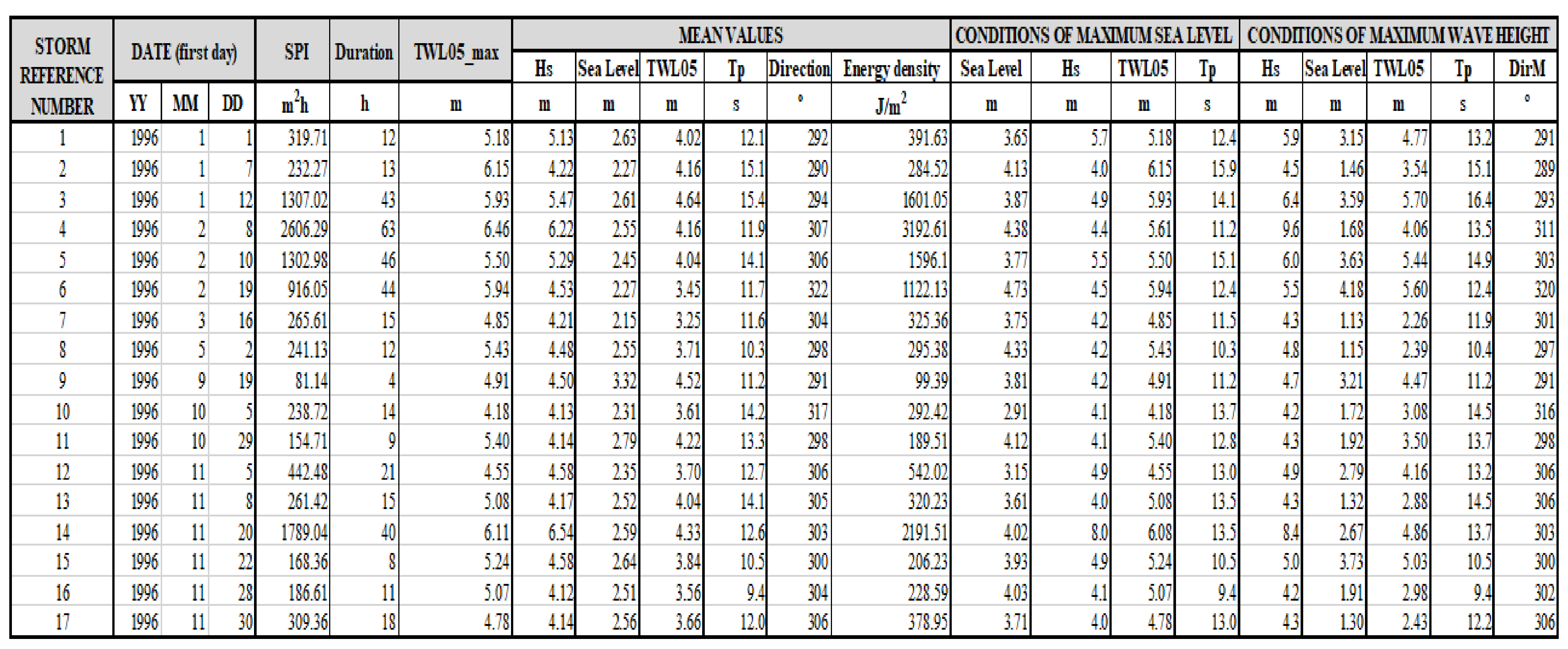

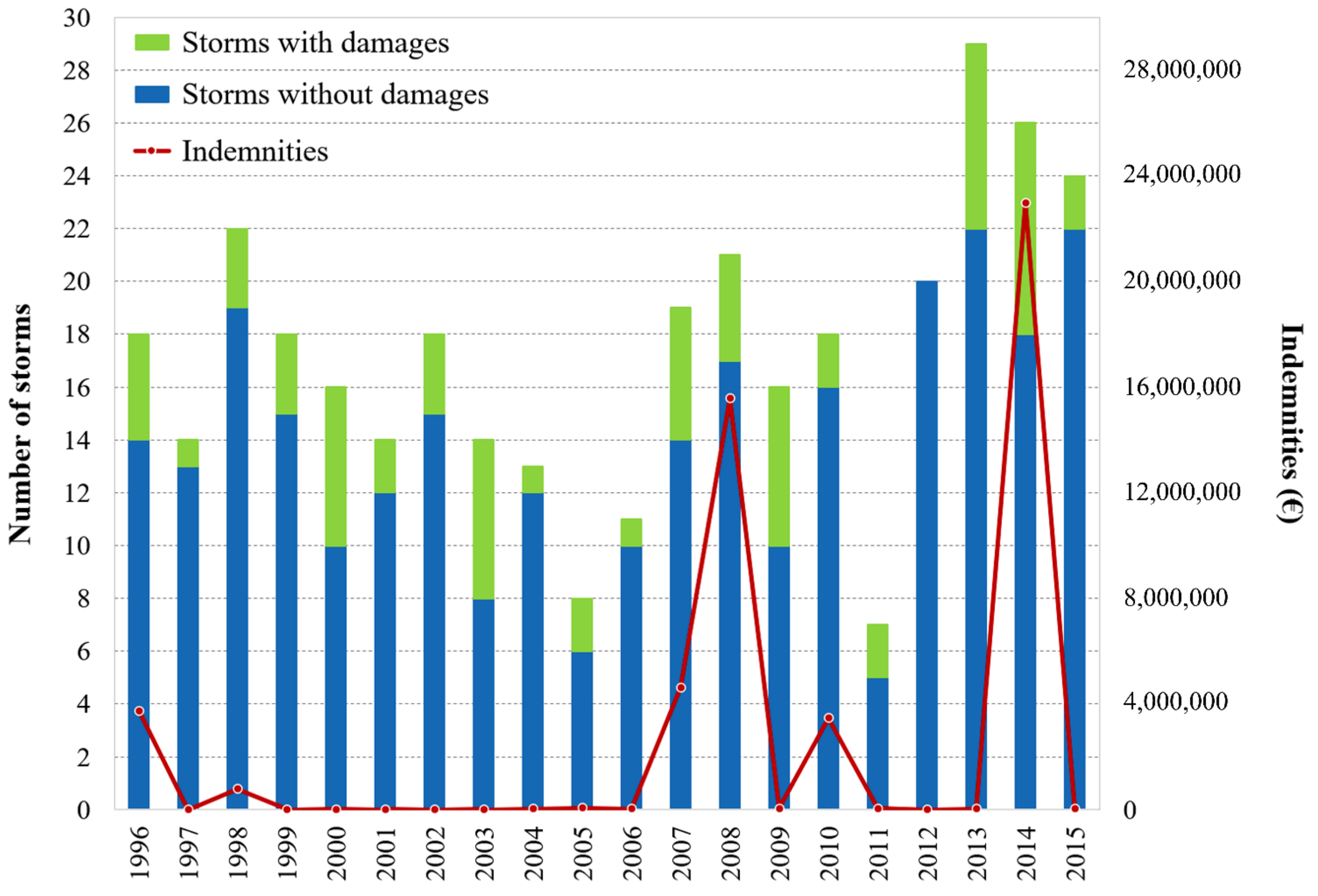
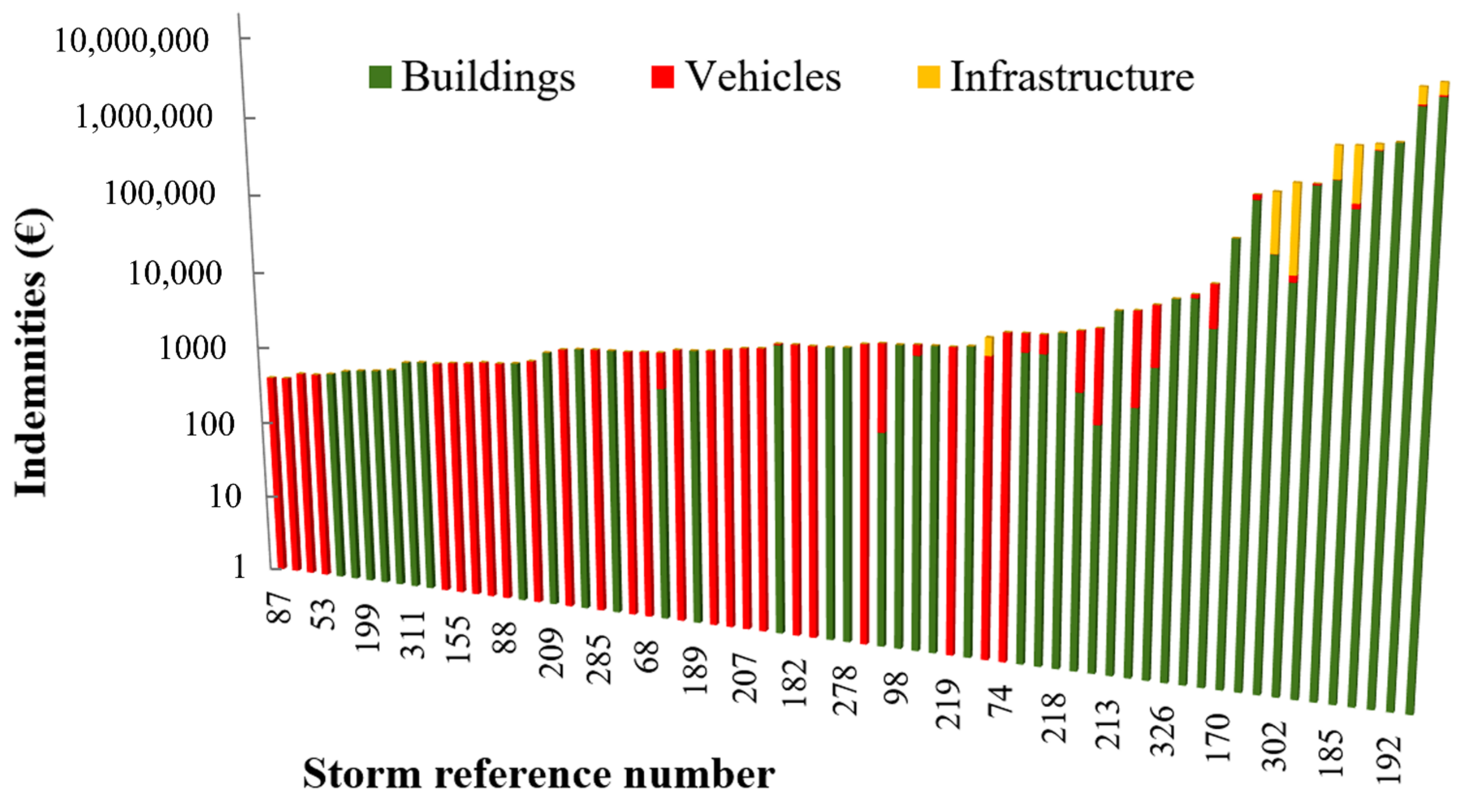
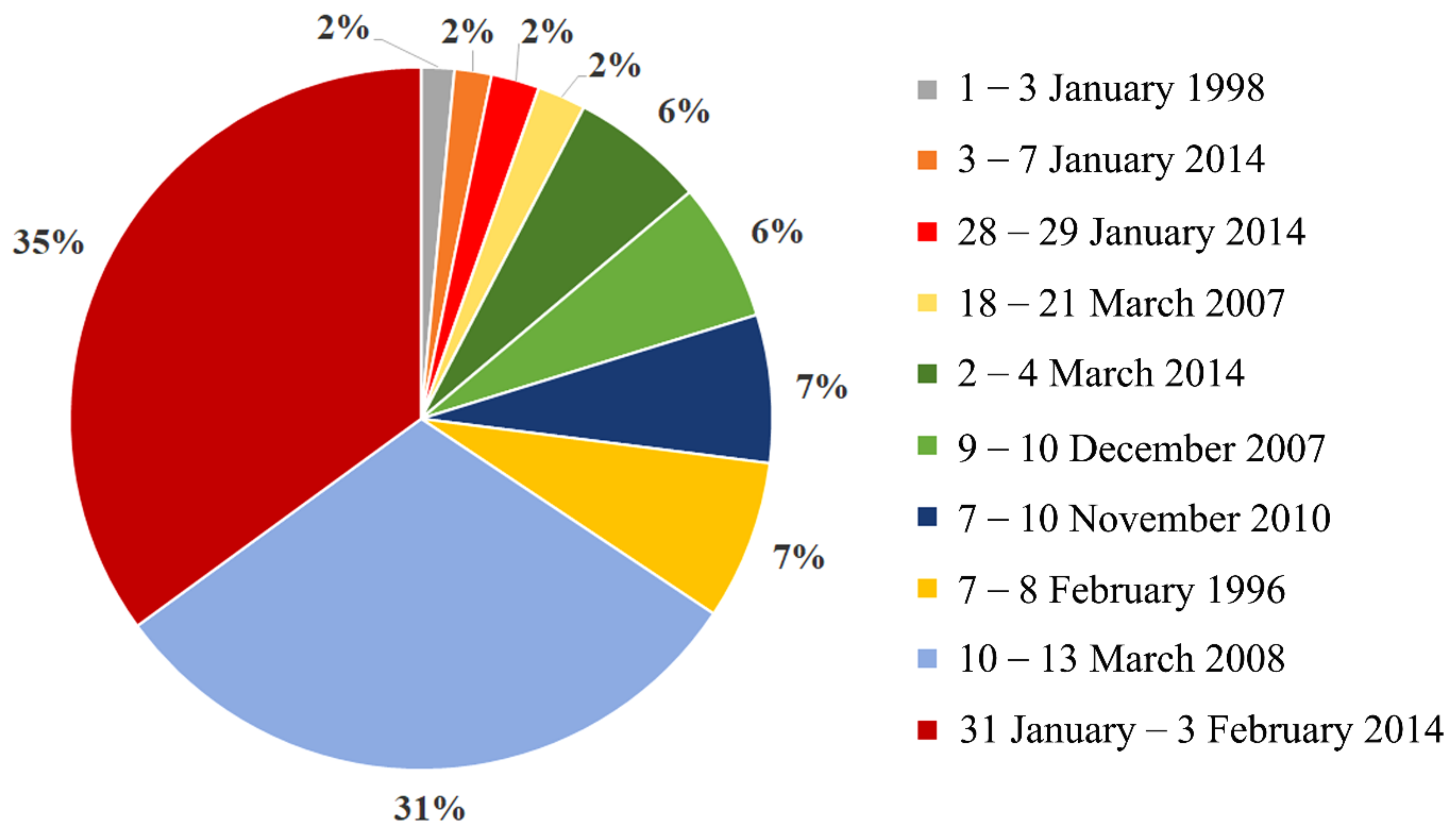
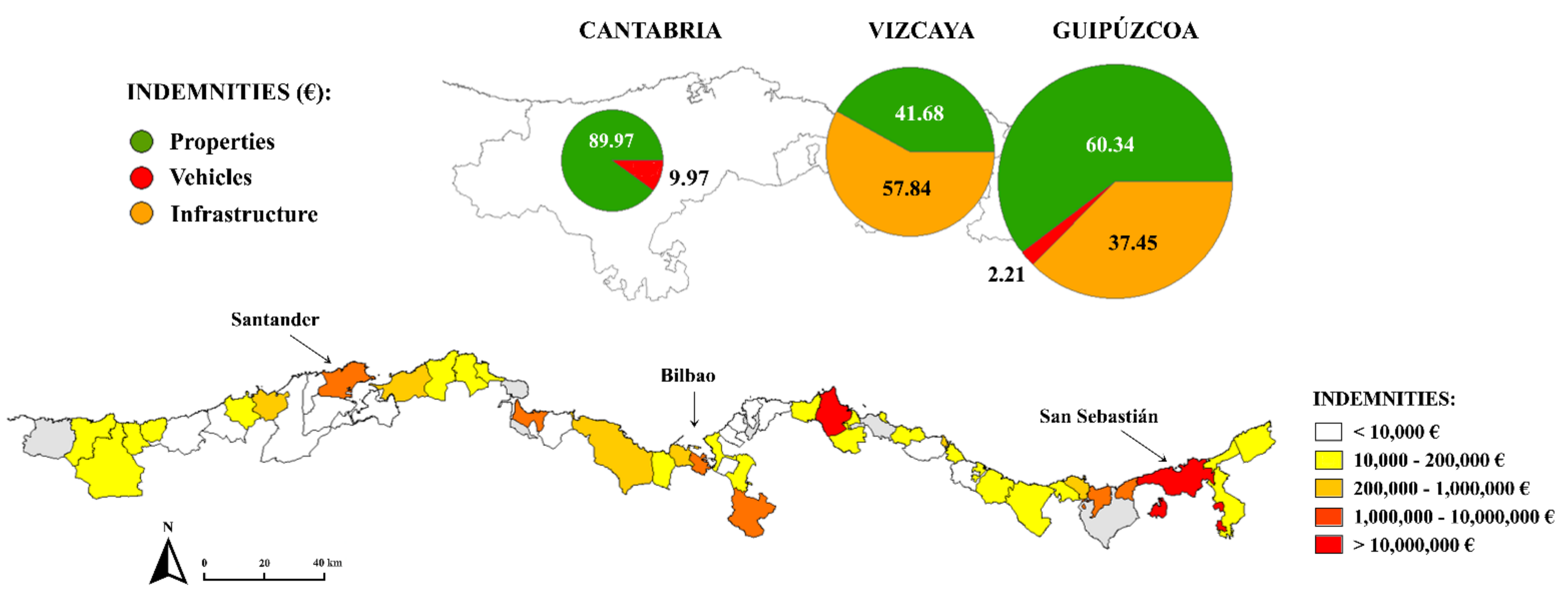
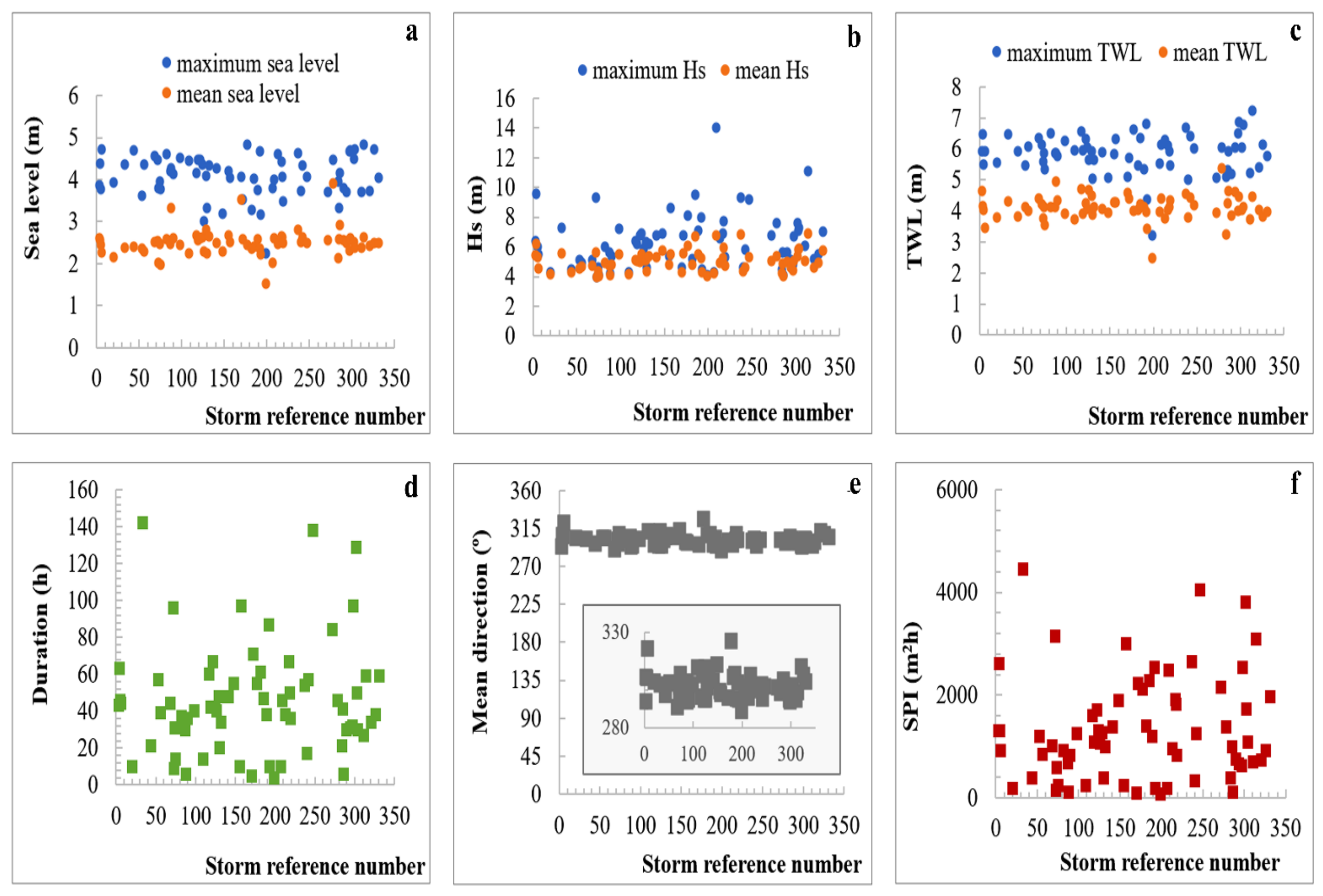
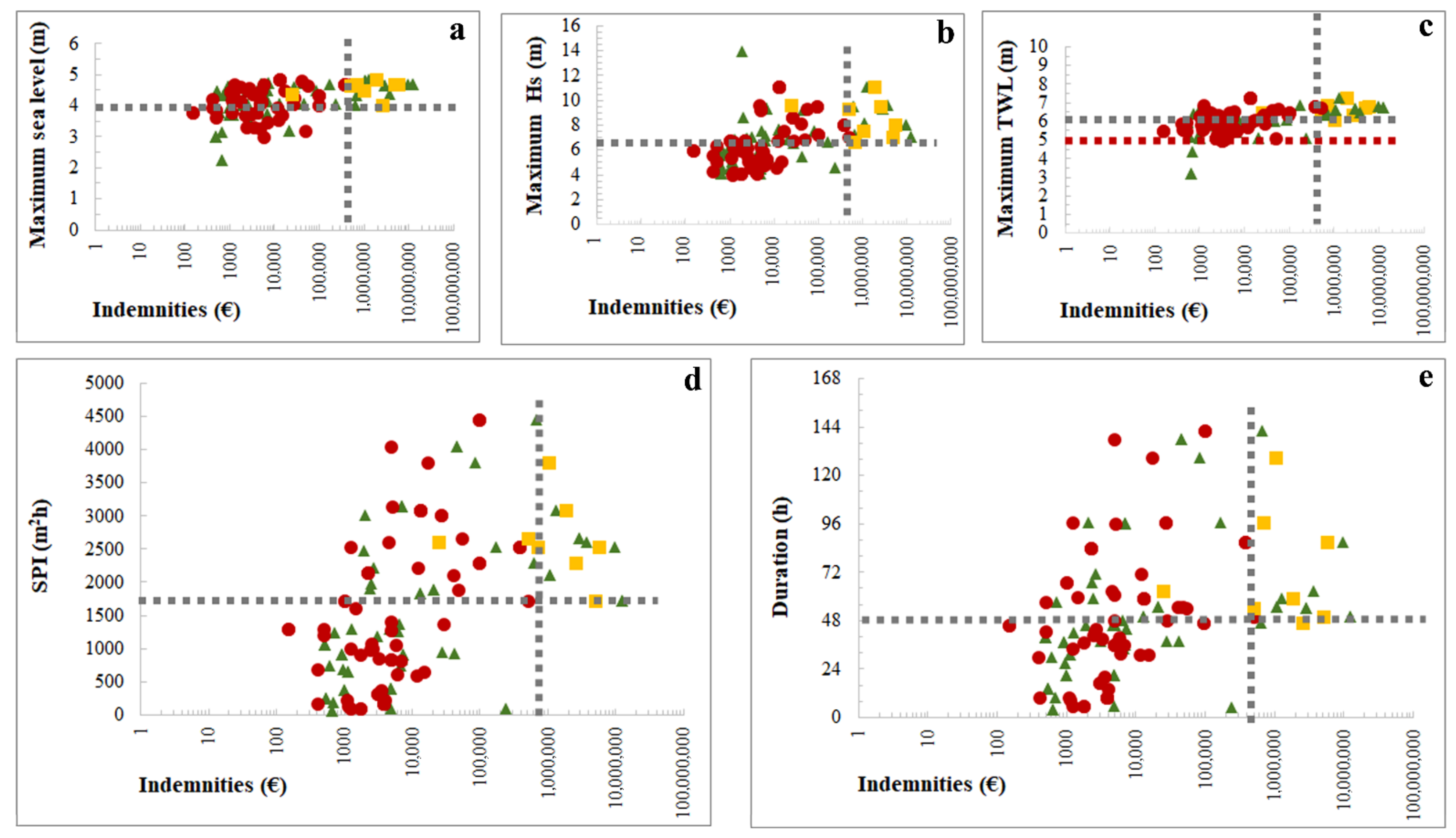
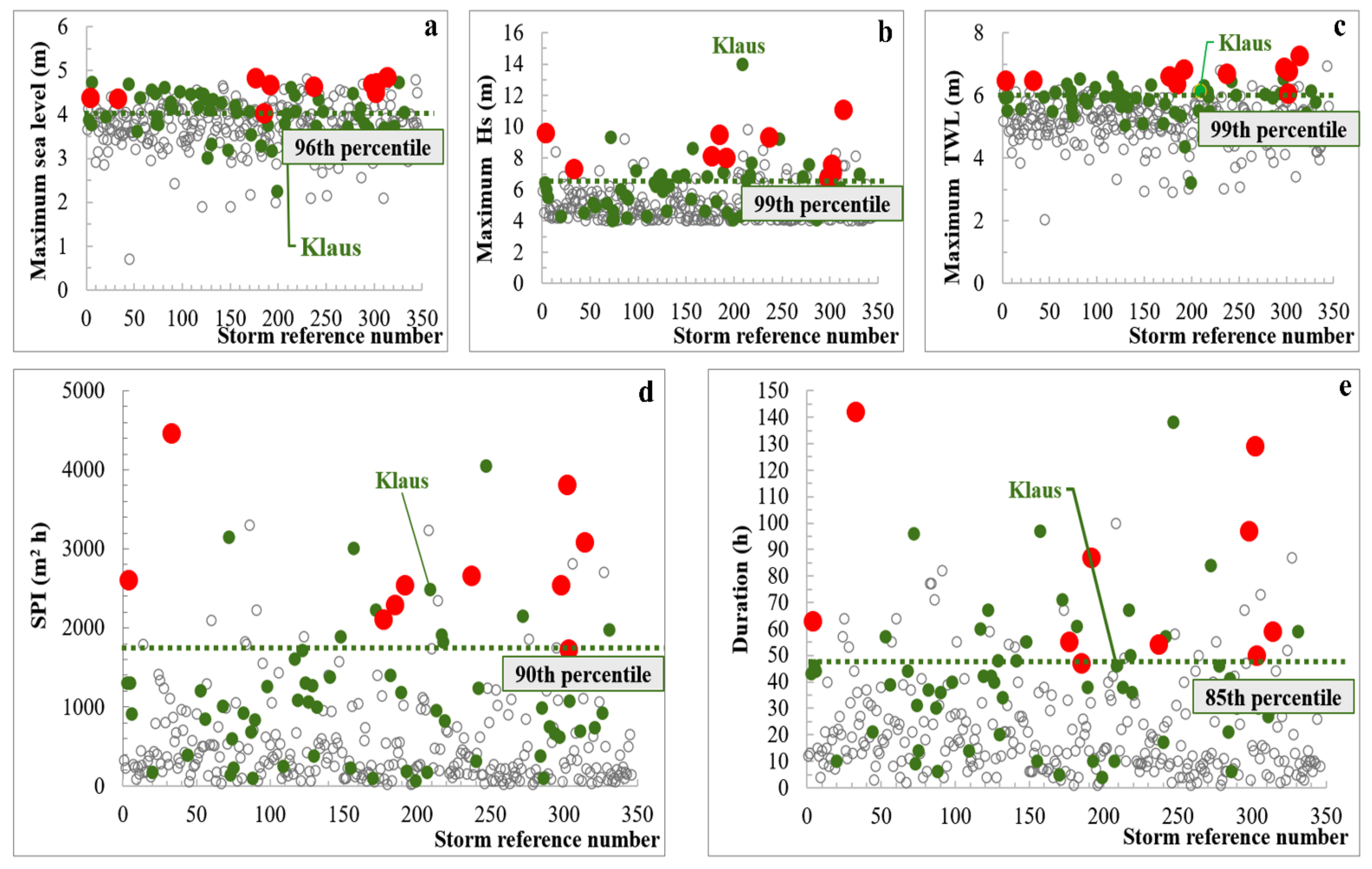
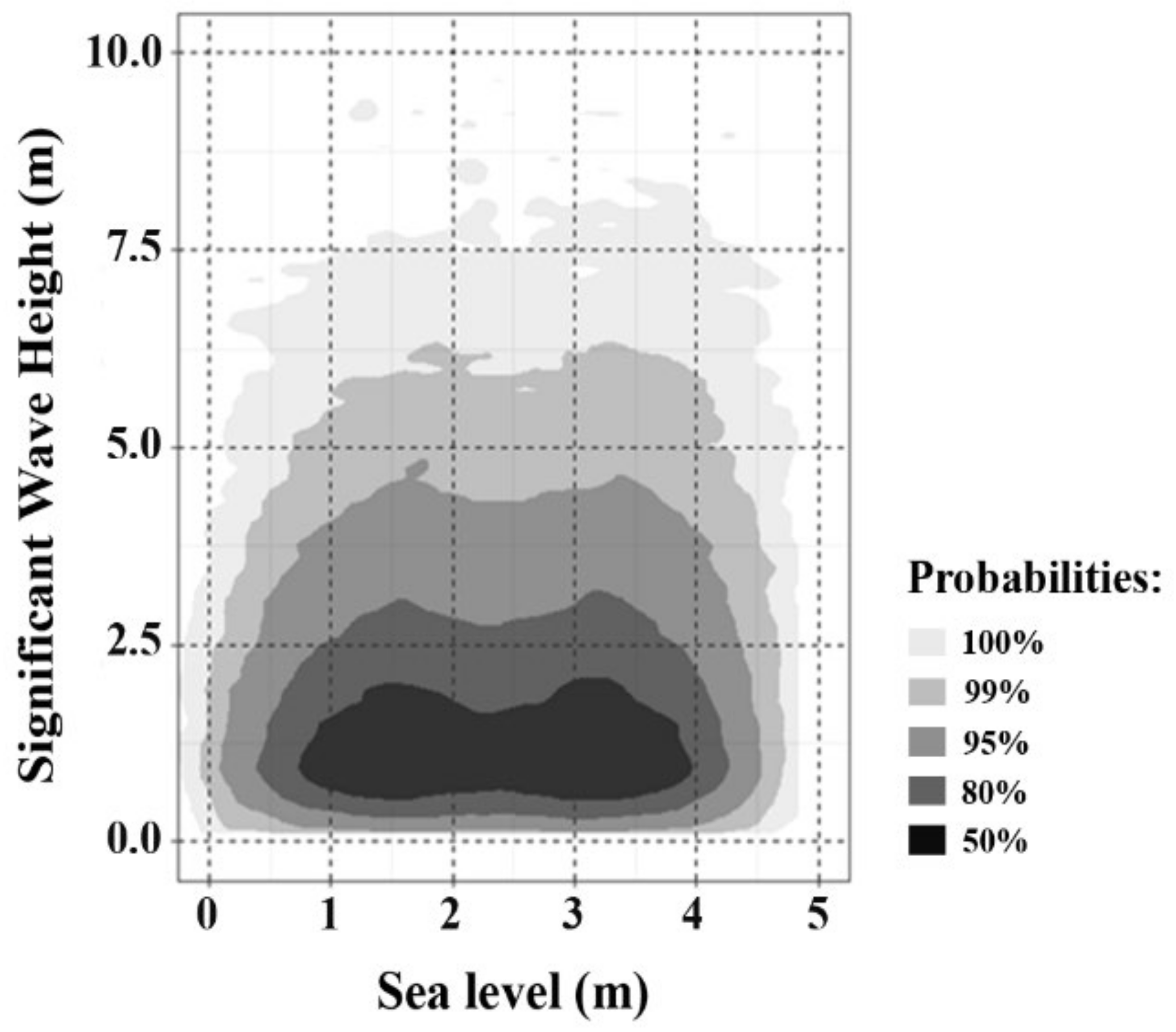

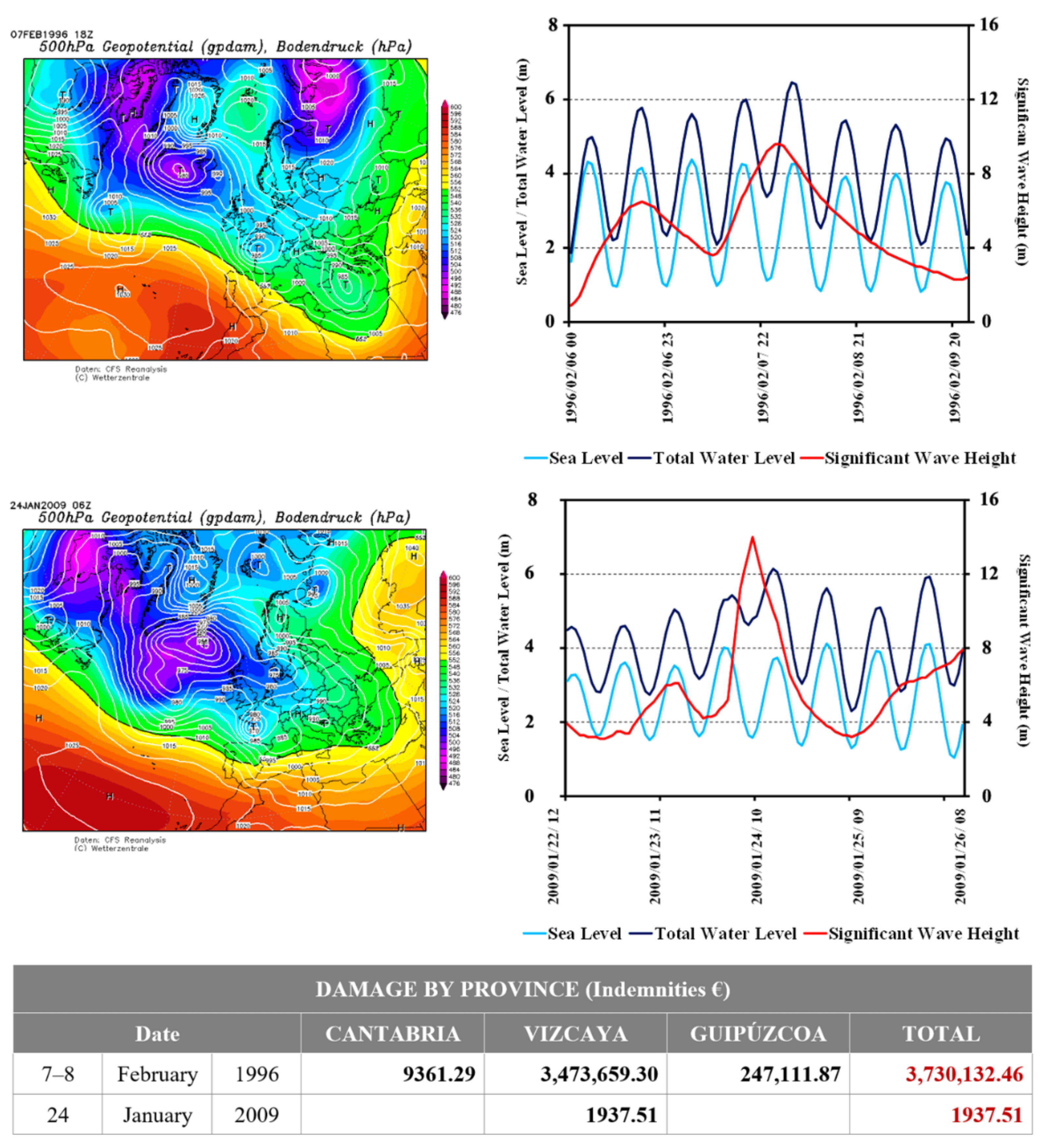
| Parameter | 7–8 February 1996 | 23–24 January 2009 (Klaus) |
|---|---|---|
| Minimum sea level pressure (Igueldo observatory) | 1000.2 (09 UTC, 7 February 1996) | 985.2 (00 UTC) |
| Maximum wind speed (Igueldo observatory) | 320°/139 km/h (20 UTC) | 270°/126 km/h (07 UTC) |
| WD/SWH/TP/SL/ TWL/UTC 1 | WD/SWH/TP/SL/ TWL/UTC 1 | |
| At the maximum SWH | 310/9.6/13.7/2.37/ 4.75/01 | 294/14.0/15.7/1.58/ 4.79/09 |
| At the maximum TWL | 313/8.9/13.7/4.26/ 6.46/05 | 298/10.0/14.9/3.69/ 6.14/14 |
Publisher’s Note: MDPI stays neutral with regard to jurisdictional claims in published maps and institutional affiliations. |
© 2022 by the authors. Licensee MDPI, Basel, Switzerland. This article is an open access article distributed under the terms and conditions of the Creative Commons Attribution (CC BY) license (https://creativecommons.org/licenses/by/4.0/).
Share and Cite
Rivas, V.; Garmendia, C.; Rasilla, D. Analysis of Ocean Parameters as Sources of Coastal Storm Damage: Regional Empirical Thresholds in Northern Spain. Climate 2022, 10, 88. https://doi.org/10.3390/cli10060088
Rivas V, Garmendia C, Rasilla D. Analysis of Ocean Parameters as Sources of Coastal Storm Damage: Regional Empirical Thresholds in Northern Spain. Climate. 2022; 10(6):88. https://doi.org/10.3390/cli10060088
Chicago/Turabian StyleRivas, Victoria, Carolina Garmendia, and Domingo Rasilla. 2022. "Analysis of Ocean Parameters as Sources of Coastal Storm Damage: Regional Empirical Thresholds in Northern Spain" Climate 10, no. 6: 88. https://doi.org/10.3390/cli10060088
APA StyleRivas, V., Garmendia, C., & Rasilla, D. (2022). Analysis of Ocean Parameters as Sources of Coastal Storm Damage: Regional Empirical Thresholds in Northern Spain. Climate, 10(6), 88. https://doi.org/10.3390/cli10060088






